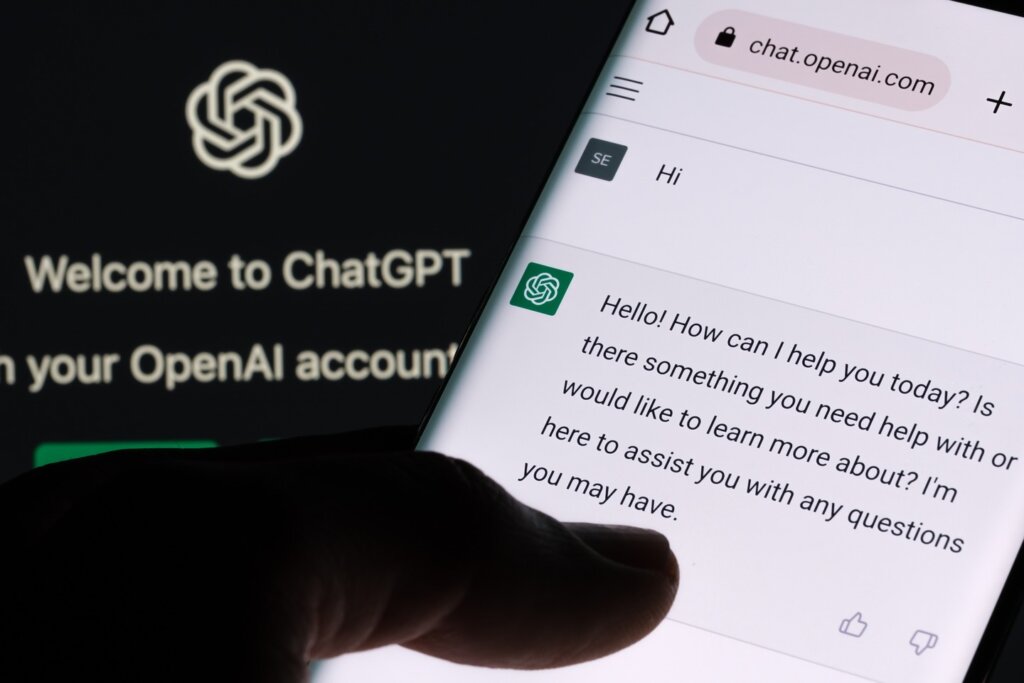
How Meta is shaping the future of technology with new AI. (Source – Shutterstock)
Can the new AI system from Meta compete with OpenAI’s ChatGPT and Google’s Bard?
- The new AI system from Meta aims to rival OpenAI and Google in generative tech.
- Businesses rapidly adopt generative AI, spotlighting the competitive landscape.
- Apple too is stepping onto the scene with Ajax.
Revolutionary strides in Artificial Intelligence (AI), especially in the realm of generative AI, have seized the public’s interest. These advancements, backed by industry giants like Microsoft and Meta, offer a glimpse into a future where AI has the potential to transform many facets of human life—ranging from personal interactions to economic systems and social structures. This technology is making good on what industry specialists have long believed—that AI is more than a mere tool; it’s a transformative force, capable of revolutionizing the way we communicate, work, and engage with the world.
We are nearly a year—or perhaps already a year—into a frenetic surge of developments in generative AI, a wave initiated by OpenAI’s launch of ChatGPT in the closing months of 2022. Unlike Meta and Google, who have been researching large language models for quite some time, OpenAI was the pioneer in recognizing that with the right blend of extensive web-scraped training data and vast computational resources, chatbots could reach nearly human conversational proficiency.
Instead of showcasing this through scholarly articles, OpenAI let ChatGPT speak for itself, creating a monumental impact. OpenAI’s models rapidly emerged as the gold standard in the industry.
Challenges in OpenAI’s horizon
However, OpenAI’s once-impervious standing has seen some cracks in the year since its initial burst of acclaim. Developers dependent on OpenAI’s technology have noted a recent slackening in both the response speed and the output quality of the bot—claims that OpenAI has contested. The most likely explanation for this decline seems to be the increasingly limited computational power available for running these models, especially given that OpenAI’s models are hosted on Microsoft’s Azure servers.
Yet, the issues plaguing OpenAI don’t end there. Meta has entered the arena with its own open-source Large Language Model (LLM), named Llama 2, designed to compete with OpenAI’s GPT-4.
For those curious about Llama 2, it is Meta’s response to Google’s PaLM 2, OpenAI’s GPT-4, and Anthropic’s Claude 2. This model has been trained on an expansive and current dataset of publicly available internet data, thereby surpassing its predecessor, Llama 1, in both data volume (by 40%) and contextual understanding (with a context length of 4k).
When pitted against other key open-source language models like Falcon or MBT, Llama 2 outperforms them in various performance indicators. According to research by MUO, Llama 2 is undeniably one of the most formidable open-source large language models on the market today. However, how it measures up to titans like OpenAI’s GPT and Google’s PaLM is still a matter of ongoing comparison.
Apple has been working on a lowkey approach to generative AI
Additionally, Apple has reportedly thrown its hat in the ring, developing an alternative to ChatGPT known as “Ajax.” Apple has also devised an internal chatbot service, unofficially dubbed “Apple GPT.”
Apple’s in-house tool, powered by Ajax, aligns closely with existing technologies like Bard, ChatGPT, and Bing AI. While it is currently a rudimentary web application not meant for public release, Apple is actively fortifying the foundational models. Industry insiders suggest that Apple is pondering various consumer applications for this tool.

Apple has been working on AI quietly. (Source – Shutterstock)
More notably, both Google and Meta have succeeded in enabling their LLMs to interact with and generate not just text but also images, a capability OpenAI had promised for its GPT-4 but has yet to deliver. As it stands, GPT-4 specializes in text and code-based outputs.
Can the new AI system from Meta live up to the hype?
Further heightening the competitive landscape, Meta is reportedly developing a new AI system, intended to rival even OpenAI’s most advanced models, according to a Wall Street Journal report published recently.
The report suggests that Meta, the parent company of Facebook, aims to have this new, more potent AI model ready by next year, and it’s expected to significantly surpass its current commercial version, Llama 2.

The original… but still the best?
Distributed via Microsoft’s Azure services, Llama 2 was Meta’s previous (for which, read “current”) attempt to challenge OpenAI’s ChatGPT and Google’s Bard. This new project is intended to enable businesses to offer more sophisticated text-based and analytical services. According to the report, Meta anticipates initiating the training phase for this ambitious new model in early 2024.
Amid this fierce competition and rapid development, the business community has not remained a bystander. Since the debut of OpenAI’s ChatGPT in late 2022, businesses and large-scale enterprises have been rushing to embrace generative AI. This emerging market has quickly become a hub for organizations seeking innovative capabilities to optimize their business processes.
The generative AI landscape is rapidly evolving, with each technological leap fostering both competitive dynamics and collaborative possibilities. Whether it’s OpenAI’s trailblazing GPT models or newcomers like Llama 2 and Apple’s Ajax, the advancements in large language models are signaling a paradigm shift in how we interact with technology and conduct business. Yet it’s crucial to remain aware of the limitations and ethical considerations as we integrate these powerful tools into our daily lives.
The next few years promise further breakthroughs and perhaps even more transformative applications, making it an exciting era for the technology industry and society. As we look to the future, we must be both excited about the immense possibilities and cautious of the ethical and technical limitations that lie ahead.
READ MORE
- Safer Automation: How Sophic and Firmus Succeeded in Malaysia with MDEC’s Support
- Privilege granted, not gained: Intelligent authorization for enhanced infrastructure productivity
- Low-Code produces the Proof-of-Possibilities
- New Wearables Enable Staff to Work Faster and Safer
- Experts weigh in on Oracle’s departure from adland






